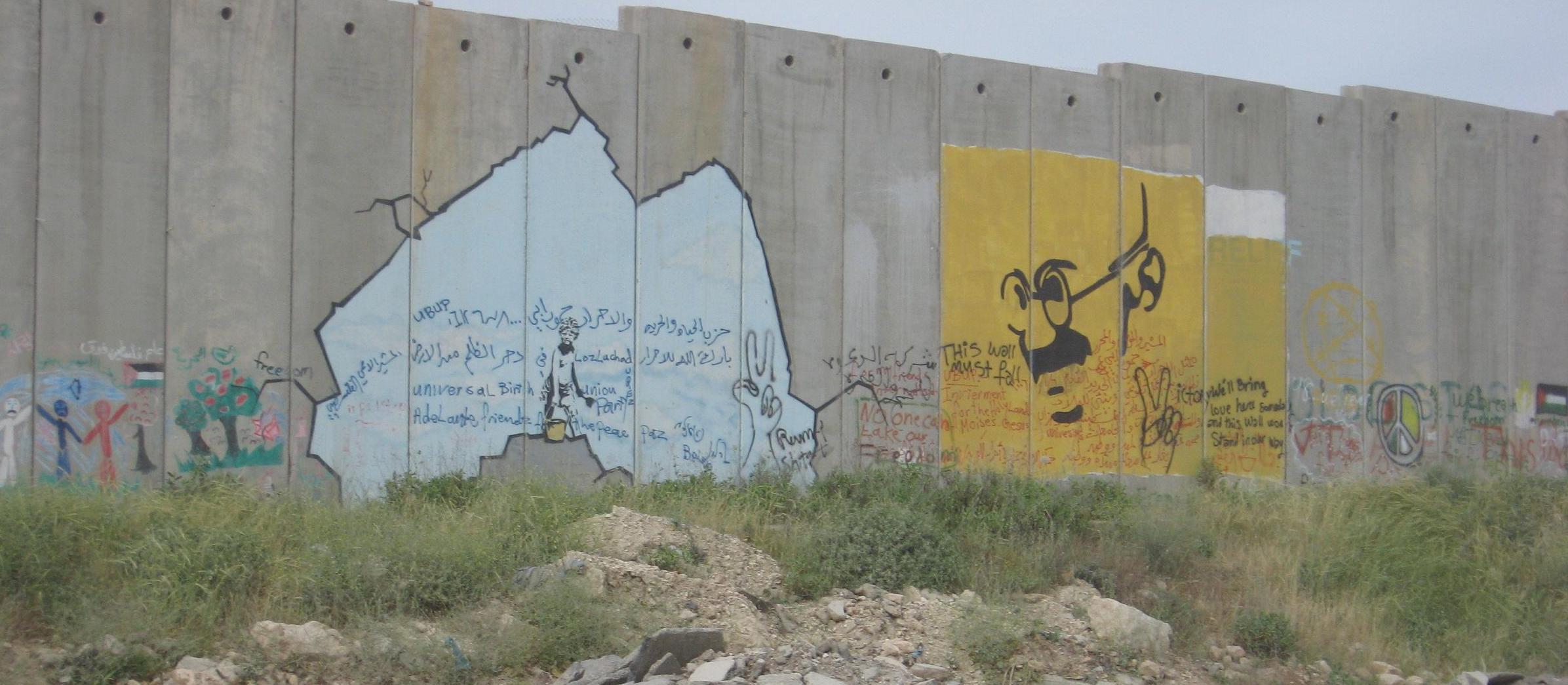
Graffiti paintings on the Israeli West Bank barrier by Banksy near Qalandia - July 2005 - Public Domain
This issue focuses on “reclaiming art” in urban public space in the MENA region. Whether visual or performative, urban arts (tags, graffiti, street art, murals, performances, live shows, sculptures and installations) contribute to renew forms of expression and politics in public space and to transform urban space. Indeed, graffiti and the street art scene have increased over the past decade in line with the so-called “Arab Spring:” every year, graffiti on walls multiply, new urban art centers appear, and festivals entirely dedicated to street art are organized. All these initiatives are gradually turning the city into an “open-air gallery” and are transforming the relationship between city dwellers and urban public space. By asking what art does to the city, the contributions in this issue question the renewal of the links between art, modes of appropriation of urban space, and forms of political expression.
Artistic practices in the MENA region is the subject of growing interest among researchers. Since the 1990s, art historians and sociologists have taken up contemporary creation as an object of study (Ali, 1987; Mikdadi Nashashibi Et Al., 1994; Naef, 1996; Armbrust, 1998; Dakhlia, 2006; Shabout, 2007; Sloman, 2009; Sabry, 2010), initially favoring aesthetic or historical analyses. Studies following this initial approach examined effects of cultural policies, such as issues related to heritage (Maffi, 2005; Rezk & Stephan-Hachem, 2006; Mejcher-Atassi, 2013; Kazerouni, 2017). Despite its introductory character, studies have recently focused on ethnographic and urban dimension of artistic production in the MENA region, thus constructing a field currently expanding (Winegar, 2006; Mermier & Puig, 2007; Dias, 2007; Ströhm, 2012; Nashef, 2012; Scheid, 2014; Alviso, 2017; Brones, 2020; Lehec, 2017; Carle, 2019).
This issue aims to enrich existing research by analyzing cities through art and to question what art does to the city. It is as much about studying spatiality of urban art as it is about making it an additional key (Gresillon, 2014) for examining spatial, social, temporal and political dimensions of urban spaces. How are the links between art, urban appropriation, and political expression renewed? The notion of city is understood here both as a medium and as a subject of creation. If materiality and urban identities can renew forms and contents of artistic expression (city as a source of inspiration in many contemporary works), art has the potential to transform the city. It invites itself into public space and the daily life of its inhabitants, diverting walls, squares or staircases from their primary functions. On a city scale, places dedicated to art are multiplying, helping to redefine centralities, but also to accelerate — while sometimes denouncing them — gentrification. On a national and international scale, the endowment of cities with museums or artistic events allows for a renewal of their image and better visibility, in a context of increased international competition between metropolises. These “announcements of museums with high international visibility” (Kazerouni, 2015, 87-97; 2007, 121-145) make them “mirror museums”, because they generate “a mirror effect, consisting in reflecting to the public they target the image of its expectations of the contemporary Muslim world, which characterizes it” (Kazerouni, 2017, 15). In these multiscale dynamics, artists and cultural agents become urban actors. Whether they take the city as subject or medium, circulate between different centralities, or invest new spaces, they contribute to changing the cityscape as representations of city dwellers.
More specifically, this issue will examine how artistic practices and productions lead to the emergence of new definitions, limits and functions of public space, in its material, social, legal and political dimensions. It will explore existing tensions between the use of art as a means of reinventing or “re-publicizing” places (Kullmann, 2013), or as a means of normalizing them (Guinard, 2013) and, in so doing, reinforcing their excluding character. Indeed, creation allows for material and symbolic reappropriations, and can become a medium for inscribing social and political demands in the sphere of public debate. In its most consensual and ornamental forms, it can also serve as a basis for normative development policies. This institutionalization of urban art also invites the authors to question its anchoring in the global art market and its place in the museum institution: how do urban arts sell and exhibit themselves outside the city walls? Finally, although urban art is not originally intended to circulate, the transfer of practices and productions from urban space to digital space is transforming trajectories of works, from their conception to their distribution and eventual recycling.
This issue is interdisciplinary in scope and invites artists and scholars to cross-reference their reflections and papers about socio-cultural and political issues of art in public space on the one hand, and the urban condition in the MENA region on the other hand. For more information, please refer to the call for proposals' detailed argumentation (in French).
Papers may answer several of these questions simultaneously or open new avenues. Proposal (abstract and short biography) may be written in French or English and should be sent before 15 December 2020 to Marie Bonte () and Marion Slitine ().
